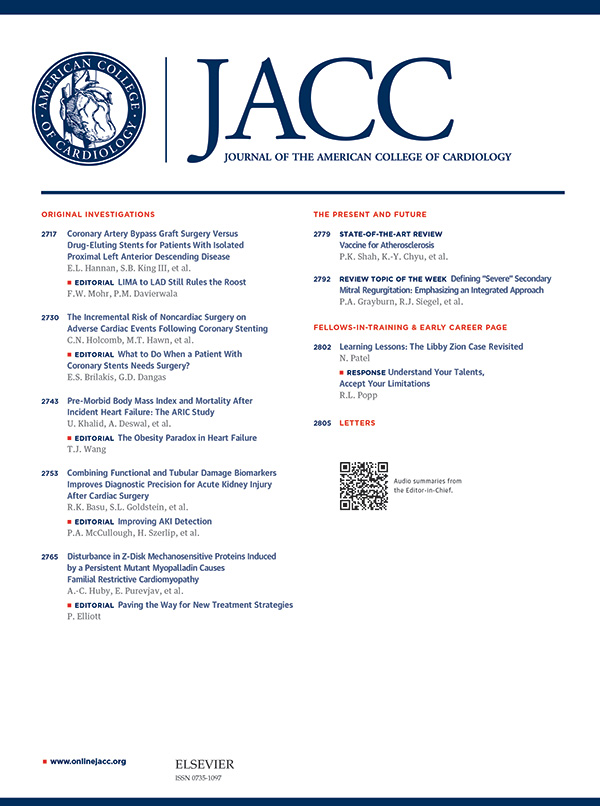Systolic Blood Pressure and Pulse Pressure in Heart Failure
IF 21.7
1区 医学
Q1 CARDIAC & CARDIOVASCULAR SYSTEMS
引用次数: 0
Abstract
Background
Hypertension is common in patients with heart failure with mildly reduced or preserved ejection fraction (HFmrEF/HFpEF), and current guidelines recommend treating systolic blood pressure (SBP) to a target <130 mm Hg. However, data supporting treatment to this target are limited. Additionally, pulse pressure (PP), a marker of aortic stiffness, has been associated with increased risk of cardiovascular events, but its prognostic impact in HFpEF has not been extensively studied.
Objectives
This study aimed to explore the impact of baseline SBP and PP on cardiovascular outcomes in patients with HFmrEF or HFpEF.
Methods
The I-PRESERVE (Irbesartan in Heart Failure With Preserved Ejection Fraction), TOPCAT (Treatment of Preserved Cardiac Function Heart Failure with an Aldosterone Antagonist)–Americas, PARAGON-HF (Prospective Comparison of Angiotensin Receptor-Neprilysin Inhibitor With Angiotensin-Receptor Blocker Global Outcomes in HF With Preserved Ejection Fraction), and DELIVER (Dapagliflozin Evaluation to Improve the Lives of Patients With Preserved Ejection Fraction Heart Failure) trials were global, randomized clinical trials testing irbesartan, spironolactone, sacubitril/valsartan, and dapagliflozin, respectively, against either a placebo or an active comparator (valsartan, in PARAGON-HF), in patients with heart failure and a left ventricular ejection fraction ≥40% (in DELIVER) or ≥45% (in the other trials). The relationship between continuous baseline SBP and PP, and the primary endpoint (first heart failure hospitalization or cardiovascular death) was analyzed with restricted cubic splines. We further evaluated the prognostic impact of SBP categories (<120, 120-129, 130-139, and ≥140 mm Hg) and PP quartiles on the primary endpoint.
Results
A total of 16,950 patients (mean age 71 ± 9 years; 49% male; mean SBP 131 ± 15 mm Hg; mean PP 55 ± 14 mm Hg) were included. The relationship between SBP and the primary endpoint was J-shaped, with the lowest risk at 120 to 130 mm Hg. A similar pattern was found for PP, with the lowest risk at 50 to 60 mm Hg. The highest SBP category (reference: 120-129 mm Hg) and PP quartile (reference: 46-54 mm Hg) were associated with a higher risk of the primary outcome (HR: 1.22; 95% CI: 1.10-1.34 and HR: 1.22; 95% CI: 1.11-1.34, respectively). Higher PP was associated with greater cardiovascular risk, regardless of SBP.
Conclusions
Our analysis of a large pooled dataset from 4 clinical trials, including >16,900 patients with HFmrEF/HFpEF, indicates a J-shaped relationship between both SBP and PP and cardiovascular risk. The lowest risk was observed at SBP levels between 120 and 130 mm Hg and PP values between 50 and 60 mm Hg (I-PRESERVE [Irbesartan in Heart Failure With Preserved Systolic Function], NCT00095238; TOPCAT [Treatment of Preserved Cardiac Function Heart Failure With an Aldosterone Antagonist], NCT00094302; PARAGON-HF [Efficacy and Safety of LCZ696 Compared to Valsartan, on Morbidity and Mortality in Heart Failure Patients With Preserved Ejection Fraction], NCT01920711; DELIVER [Dapagliflozin Evaluation to Improve the LIVEs of Patients With PReserved Ejection Fraction Heart Failure], NCT03619213)
心力衰竭患者的收缩压和脉压:四项试验的参与者层面汇总分析
背景高血压在射血分数轻度降低或保留的心力衰竭(HFmrEF/HFpEF)患者中很常见,目前的指南建议将收缩压(SBP)治疗目标设定在 130 mmHg 以下。然而,支持这一治疗目标的数据十分有限。此外,脉压(PP)是主动脉僵化的标志物,与心血管事件风险的增加有关,但其对 HFpEF 预后的影响尚未得到广泛研究。本研究旨在探讨基线 SBP 和 PP 对 HFmrEF 或 HFpEF 患者心血管预后的影响。方法I-PRESERVE、TOPCAT-Americas、PARAGON-HF 和 DELIVER 是全球性的随机临床试验,在左心室射血分数≥40%(DELIVER)或≥45%(其他试验)的高频患者中分别测试厄贝沙坦、螺内酯、沙库比特利/缬沙坦和达帕格列酮,与安慰剂或活性比较药(缬沙坦,在 PARAGON-HF 试验中)进行对比。连续基线SBP和PP与主要终点(首次心房颤动住院或心血管死亡)之间的关系用受限三次样条进行了分析。我们进一步评估了 SBP 类别(<120、120-129、130-139、≥140 mmHg)和 PP 四分位数对主要终点的预后影响。结果 共纳入 16950 例患者(平均年龄 71±9岁,49% 为男性,平均 SBP 131±15mmHg,平均 PP 55±14mmHg)。SBP 与主要终点之间的关系呈 "J "形,120-130 mmHg 时风险最低。PP 也呈类似模式,50-60 mmHg 时风险最低。最高 SBP 类别(参考值:120-129 mmHg)和 PP 四分位数(参考值:46-54 mmHg)与较高的主要结局风险相关(HR:1.22;95% CI:1.10-1.34;HR:1.22;95% CI:1.11-1.34)。结论我们对来自四项临床试验的大型汇总数据集(包括超过 16,900 名 HFmrEF/HFpEF 患者)进行的分析表明,SBP 和 PP 与心血管风险之间存在 "J "形关系。SBP水平在120至130毫米汞柱之间、PP值在50至60毫米汞柱之间时风险最低。
本文章由计算机程序翻译,如有差异,请以英文原文为准。
求助全文
约1分钟内获得全文
求助全文
来源期刊
CiteScore
42.70
自引率
3.30%
发文量
5097
审稿时长
2-4 weeks
期刊介绍:
The Journal of the American College of Cardiology (JACC) publishes peer-reviewed articles highlighting all aspects of cardiovascular disease, including original clinical studies, experimental investigations with clear clinical relevance, state-of-the-art papers and viewpoints.
Content Profile:
-Original Investigations
-JACC State-of-the-Art Reviews
-JACC Review Topics of the Week
-Guidelines & Clinical Documents
-JACC Guideline Comparisons
-JACC Scientific Expert Panels
-Cardiovascular Medicine & Society
-Editorial Comments (accompanying every Original Investigation)
-Research Letters
-Fellows-in-Training/Early Career Professional Pages
-Editor’s Pages from the Editor-in-Chief or other invited thought leaders

 求助内容:
求助内容: 应助结果提醒方式:
应助结果提醒方式:


